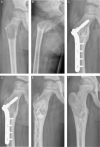Do's and Don'ts in Primary Aneurysmal Bone Cysts of the Proximal Femur in Children and Adolescents: Retrospective Multicenter EPOS Study of 79 Patients
- PMID: 36102541
- PMCID: PMC9746336
- DOI: 10.1097/BPO.0000000000002267
Do's and Don'ts in Primary Aneurysmal Bone Cysts of the Proximal Femur in Children and Adolescents: Retrospective Multicenter EPOS Study of 79 Patients
Abstract
Background: Aneurysmal bone cysts (ABC) are rare benign cystic bone tumors, generally diagnosed in children and adolescents. Proximal femoral ABCs may require specific treatment strategies because of an increased pathologic fracture risk. As few reports are published on ABCs, specifically for this localization, consensus regarding optimal treatment is lacking. We present a large retrospective study on the treatment of pediatric proximal femoral ABCs.
Methods: All eligible pediatric patients with proximal femoral ABC were included, from 11 tertiary referral centers for musculo-skeletal oncology (2000-2021). Patient demographics, diagnostics, treatments, and complications were evaluated. Index procedures were categorized as percutaneous/open procedures and osteosynthesis alone. Primary outcomes were: time until full weight-bearing and failure-free survival. Failure was defined as open procedure after primary surgery, >3 percutaneous procedures, recurrence, and/or fracture. Risk factors for failure were evaluated.
Results: Seventy-nine patients with ABC were included [mean age, 10.2 (±SD4.0) y, n=56 male]. The median follow-up was 5.1 years (interquartile ranges=2.5 to 8.8).Index procedure was percutaneous procedure (n=22), open procedure (n=35), or osteosynthesis alone (n=22). The median time until full weight-bearing was 13 weeks [95% confidence interval (CI)=7.9-18.1] for open procedures, 9 weeks (95% CI=1.4-16.6) for percutaneous, and 6 weeks (95% CI=4.3-7.7) for osteosynthesis alone ( P =0.1). Failure rates were 41%, 43%, and 36%, respectively. Overall, 2 and 5-year failure-free survival was 69.6% (95% CI=59.2-80.0) and 54.5% (95% CI=41.6-67.4), respectively. Risk factors associated with failure were age younger than 10 years [hazard ratios (HR)=2.9, 95% CI=1.4-5.8], cyst volume >55 cm 3 (HR=1.7, 95% CI=0.8-2.5), and fracture at diagnosis (HR=1.4, 95% CI=0.7-3.3).
Conclusions: As both open and percutaneous procedures along with osteosynthesis alone seem viable treatment options in this weight-bearing location, optimal treatment for proximal femoral ABCs remains unclear. The aim of the treatment was to achieve local cyst control while minimizing complications and ensuring that children can continue their normal activities as soon as possible. A personalized balance should be maintained between undertreatment, with potentially higher risks of pathologic fractures, prolonged periods of partial weight-bearing, or recurrences, versus overtreatment with large surgical procedures, and associated risks.
Level of evidence: Level IV, therapeutic study.
Copyright © 2022 The Author(s). Published by Wolters Kluwer Health, Inc.
Conflict of interest statement
The authors declare no conflicts of interest.
Figures





References
-
- WHO Classification of Tumours Editorial Board, Soft tissue and bone tumours-aneurysmal bone cyst. WHO Classification of Tumours, 5th ed. Lyon: International Agency for Research on Cancer; 2020:3.
-
- Mascard E, Gomez-Brouchet A, Lambot K. Bone cysts: unicameral and aneurysmal bone cyst. Orthop Traumatol Surg Res. 2015;101(suppl 1):S119–S127. - PubMed
-
- Canavese F, Samba A, Rousset M. Pathological fractures in children: diagnosis and treatment options. Orthop Traumatol Surg Res. 2016;102(suppl 1):S149–S159. - PubMed
Publication types
MeSH terms
LinkOut - more resources
Full Text Sources
Medical
Research Materials

